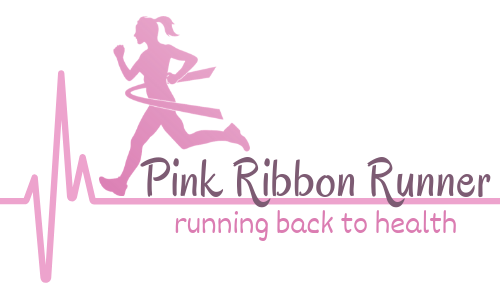Training to Run a 5K Race: a Guide for Cancer Survivors
Training to run a 5km race can be a daunting task for beginner runners, but with the proper training plan it can be a fun and very rewarding experience. A 5 km distance is a great goal for someone just learning to run. It is also a good distance to aim for if you are a cancer survivor wanting to increase your fitness. In this article, I provide you with the information you need to get started and successfully run your first 5km race.
This post contains affiliate links. As an Amazon Associate, I earn from qualifying purchases.
Disclaimer: Any exercise poses a risk of serious injury or death. Before participating in any exercise program, please discuss it with your health care provider. Those with heart problems or currently under medical treatment are strongly encourage to start with a walking program first after discussing it with their doctor.
Teaching Cancer Survivors to Run
When I first started Pink Ribbon Runner, I thought I would teach cancer survivors to run. I was doing this at an in-person run clinic already. So, why not expand my horizons to help more people online. But Pink Ribbon Runner has morphed to become so much more than just running. I am tremendously happy and proud of what it has become. From the feedback of many cancer survivors, my website is helping so many people live better lives. But, for this article, I thought I would get back to what I originally intended; teaching cancer survivors and others to run.
Let’s talk about preparing for a 5 km road race.
Running and Fighting Cancer
There are so many benefits to regular running. It can help lower blood pressure, improve immunity, reduce risk for diabetes and obesity, and strengthen the body and heart, to name a few. But research has shown that running also can improve pain, help recovery from treatments, reduce risk of cancer recurrence, and improve the quality of life in cancer survivors.
If you want to read more about this, check out these articles:
Running Helps Cancer Survivors Live Longer
Running Helps Brain Function in Cancer Survivors
Running Can Reduce Pain in Cancer Survivors
But, Running is Hard!
Yes, sustained endurance running is difficult. It is even harder after cancer treatments wreck havoc with your body and health. But, if it was easy, it wouldn’t be as satisfying to reach your distance goals. And, trust me, it is immensely satisfying to complete your first 5 km race after cancer treatments are finished. In fact, it was crossing the finish line of my first 5 km race that lit the spark in me to keep going. It was such a powerful emotional mix of happiness, pride, and surprise. I wanted more of that thrill of finishing. So, I kept going. And I encourage you to try it out for yourself too.
Running is difficult to do, for anyone. But I know that if you set your goal, start, and slowly build over the weeks of a good training plan, you absolutely can run your first race too. A 5-kilometer race is a good goal to start with. So, let’s talk about training to run this distance.
How Do I Train to Run an Endurance Race After Cancer?
The 5-kilometer (equivalent to 3 miles) road race is one of the most popular distances. According to the International Institute for Race Medicine, there were 2.9 million runners in 5K races in 2018. That is a lot of runners. Running has grown by 57% over the past 10 years. I think it is wonderful that runners in their 40s, 50s, 60s and 70s are still taking up the sport. This just shows you how amazingly achievable running 3 miles can be.
So, how do you start training for your very first 5-kilometer road race? Let’s start with planning.

Step One: Pick Your Road Race
Are you excited and eager to pick a road race to run? Well, hang on a second! There are a few things for you to consider first, once your oncologist says to go ahead.
How Far Will You Run?
The first step is to determine how far you want to run. Like this article stated, running a 5K road race is a great place to start. Although, I have known new runners to pick other distances, which is fine. However, you will need to be able to run 3 miles before you can run a half marathon, for example. So, why not race a 5K event and see how you do, before continuing with your training for the half marathon?
Pick a Date At Least 12 Weeks Away
Don’t pick a race that is coming up too soon. You want to give yourself at least 12 weeks to train and prepare for the distance, especially if you are new to running and recovering from cancer treatments. It is even better to pick a race that is 16 weeks out to give yourself a little time for drop-down or rest weeks. I will explain what those are a little later in this post.
Where Will You Race?
Next, consider where you will race. Will it be an in-person race or a virtual event? For your first race, if possible, run in-person. The atmosphere is so exciting and thrilling when you are surrounded by other runners. I wouldn’t want you to miss this experience. It seriously makes running a contagious sport.
But if a virtual event is all that is available, then go for it. Virtual events can be fun too. And they usually have gorgeous medals and swag. Try to find a virtual event with an online community that lets you share your training and experience, as that will keep you motivated to keep going.
Study Your Chosen Racecourse
The next step is to look at the racecourse.
How many water stations do they have? How far apart are the water stations? You may need to carry your own water if there are none on course, or even if they are spaced too far apart. Train by carrying water with you. It is important to stay hydrated.
Are there bathrooms provided on course? Bathrooms are very important too!
What is the terrain? Will you be running on pavement, gravel, trail ground, sand, or snow? Are there hills you will need to run? How high are those hills?
Get to know the course so that you can train and prepare for that particular course. You don’t want surprises on race day. If you are able, drive the racecourse before planning your training. Some local runners will even run a few training runs on the specific route, but this isn’t necessary.
Step Two: Plan Your Long Runs
Your longest runs will increase each week until race day. These are the most important runs in your training schedule, as they are the ones that build the fitness and endurance needed for the distance you picked in Step One.
Most runners will run their longest run on either Saturday or Sunday due to their work schedule. The other reason is that race day is also usually on a Saturday or Sunday, for consistency. The day of the week you pick should be a day you can consistently run. You should only run one long run per week, so pick a day that is best for you.
Put your race day in your calendar. Circle it, highlight it, or mark it with a sticker. It should stand out when you flip through. You will be more motivated to keep running if it really stands out as a reminder of what you are trying to achieve.
Then, add in your long runs going backwards until you reach 12 or 16 weeks, whichever schedule you picked in Step One. You want to plan your long runs so that you are increasing gradually each week. Attempting to progress too quickly feels harder and you risk overtraining and injuring yourself.
Sample 5 km Long Run Training Plan
So, for a 5 km run, your long runs might look something like this:
| Race Day | 5K |
| Week 11 | 2K |
| Week 10 | 5K |
| Week 9 | 4K |
| Week 8 | 3K |
| Week 7 | 4K |
| Week 6 | 3K |
| Week 5 | 2K |
| Week 4 | 3K |
| Week 3 | 3K |
| Week 2 | 2K |
| Week 1 | 2K |
A Few Long Run Training Plan Tips
You may have noticed a few things about that long run schedule example:
- It is not a linear progression. It doesn’t increase 2 km, 3 km, 4 km to 5 km. Instead, it jumps around a little, gradually increasing over the 12 weeks, but not necessarily increasing every week.
- The example schedule starts off with a 2K long run, which, for most beginners takes about 15-20 minutes. This distance is usually very achievable for beginners, especially if using a run/walk method (see below). But you could certainly start off with a shorter distance depending on your current fitness. Just allow yourself more time to get to the 5K distance, perhaps with a 16-week plan instead.
- The distance increases gradually over the weeks. You don’t actually run 5 km until week 10.
- After you run 5km in week 10, you have a drop-down long run of only 2 km the week before race day. This is to rest your body so it can recover and prepare for racing. This is known as “The Taper”, which should start about two weeks before race day. There are no benefits to increasing during this two week window, because your body won’t have enough time to recover and perform to its best on race day.
- Some other weeks drop down in distance too. These are “rest” weeks to help your body recover from the strain of increasing distances. A good rule of thumb is to increase your run difficulty for 2 weeks, then drop down the next week. Pick it up the following week and again increase for 2 weeks, then drop down the next. This exact drop-down week may vary with each training plan. However, the important point is to let your body adjust and rest periodically in your training schedule.
What are Run/Walk Training Plans?
Another important point is that when you are just starting out, these distances don’t have to be straight running. Many beginner training schedules combine walking intervals. For example, your first 2K long run could have you running for 2 minutes and walking for 1 minute in a pattern over the 2K distance. This is perfectly acceptable.
As you improve over the weeks, you can gradually increase the time you are running. So, eventually you could be running for 5 or 10 minutes and walking for 1 minute, for example.
I have seen runners use all sorts of these run/walk interval patterns in races. I ran my first 5 km race in 5 minutes running and 1 minute walking intervals. Do what you need to do to cross that finish line. The goal is to finish. So run or walk, just get to the end. It’s all good.
What is Long Slow Distance?
All your long runs should be at an easy run pace. This is known as LSD, or Long Slow Distance. You don’t need to, and shouldn’t, run at race pace during your long training runs.
Running slower trains your body to use energy and nutrients more efficiently. All those benefits of running are found at slower paces anyways. You don’t need to run fast to be successfully fitter.
You can also maintain a better posture if you are running slower and not tiring out your muscles.
If you want to run faster, leave your speed work for other, shorter runs during the week.

Step Three: Plan The Rest of Your Weekly Runs
So, after you schedule your long runs, you want to look at the rest of the week. To improve, you should be aiming to run at least 3 times per week. Most training programs recommend running 4 to 5 times during the week.
Keep in mind that the more you run, the better you will improve. If you are only running 3 times per week and want to run faster, you will need to work harder during your other weekly runs.
But you also need to balance this out with your current health and fitness levels too. If you only want to run 3 easy days per week, then run 3 easy days per week. You get to decide on your own training.
Schedule in Rest Days
You don’t want to run 7 days a week when starting out. Always schedule in rest days. You want to allow your body time to recover. Rest days are best scheduled after a harder workout, like your long runs, hills, or speedwork.
And if you need an extra rest day here and there, then take it. But try to run at least 3 days per week to achieve to your run goals.
These articles on Muscle Recovery may interest you:
Runner’s Guide to Muscle Recovery Part One
Runner’s Guide to Muscle Recovery Part Two
Schedule One or Two Harder Workouts per Week.
Remember in Step One I told you to study the course? Well, you will want to schedule in one or two harder workouts during your week based on that racecourse.
If you have hills to run on race day, you will want to run some hills during training.
And if you have a speed goal or finishing time in mind, you will want to schedule in some speed work during the week.
Mind you, just running can be a hard enough workout for a beginner or after cancer treatments. So, don’t feel obligated to do any of these harder workouts when you are just starting. Just making it to the finish line of your race is a perfectly acceptable goal. If it is your first race, you are guaranteed to run a personal best finish time, regardless.
Run Shorter Runs during the Week
Your runs during the week usually are not the same distance as your long runs. However, if you are just starting out, sometimes running 2K several times per week is a good strategy. But, as your distance increases, you don’t want to adopt this same strategy for the 4K distance, for example. You don’t want to be running 4 km several times per week, unless you are training for longer races, such as a half marathon. So, think of your weekly runs as shorter runs.
Hill Training or Trail Running
If your racecourse has hills, towards the end of your training schedule, add in some hill runs. If your racecourse has a different terrain, such as gravel road or wilderness trails, then you want to practice some runs on those surfaces. Try to mimic what you will be experiencing on race day if you can.
But, again, it is perfectly acceptable to just run, without adding in harder workouts, if your goal is only to finish the distance on race day.

Run Training Plans for Cancer Survivors
If all this is confusing to you, you could find a beginners run training plan online. There are many free plans that you can download and follow. Just know that you can modify these plans to suit your level as needed. A lot of the online beginner plans are harder than they need to be. And they are not designed for cancer survivors, with all our limitations and issues, specifically.
Best 5K Training Plans for Beginners
The next three run plans are not specifically developed for cancer survivors, but they are a good place to start.
I followed John Stanton’s Learn to Run Plan when I first started running. It is a good 12-week plan that used run/walk intervals to increase stamina and endurance. It isn’t an easy plan for a cancer survivor, but I know many who successfully made it through this program.
Hal Higdon also has a good novice 5K training plan. It is an 8-week plan that does not include drop-down long run weeks. However, you could easily extend this to a 12-week plan and incorporate your own drop-down weeks.
And my favorite training plan is the 80/20 running plans by Matt Fitzgerald. His run plans incorporate 80% easy runs, with only 20% of the training being hard. It is a gentle way to start running.
Find a Training Plan that Works for You
I hope you can find a training program that suits your level and style best. Modify it as you need to. Or, better yet, consider hiring a personal trainer, run coach, or joining a local run group for personal modifications, safety, motivation, and fun.
It is possible to run after cancer.
I hope you will at least try it out to see if this wonderful sport is a good fit for you.
photo credits: depositphotos.com









This is such an in-depth helpful post!
I am glad you found it helpful.
Such a helpful post to encourage someone to start running especially after having a cancer. I wish I have seen this before when Im just a newbie runner.
Great tips. I am always impressed by those who run long distances. It takes alot of dedication to do so. Running outdoors among nature is always best for me.
This is a great plan and really specific for even non-cancer survivors. Thanks for sharing!
great article I always love reading your articles.
Thank you Jimmy. Always a pleasure to have you stop by my website.
Coming from a family with a long history of breast cancer, it warms my heart every time I see posts like this. I am happy that so many cancer survivors are receiving your help. My aunt is 50 years old and a cancer survivor, she is also starting to run so this guide is perfect for her. Thanks for all the details you provided here.
I am so happy that you aunt has discovered the many benefits of running. I wish her all the best in her upcoming events.
I liked that you offered training plans. Thanks!
The long run training plan is a good place to start developing a custom plan for yourself, yes. Thank you.
Such a helpful article. I love the way you motivate and inspire others in those tough moments. Thank you for sharing <3
Thank you for taking the time to comment.
Love this! I got into running when my
Good friend, who was a runner, got diagnosed with cancer. I find running to be cathartic. The perfect answer to a rough day. This training plan is great because it’s easy to over do it when you’re starting out.
Thank you! Keep on Running! 🙂